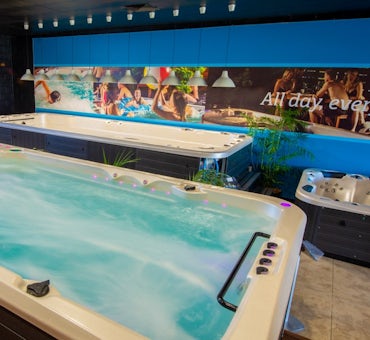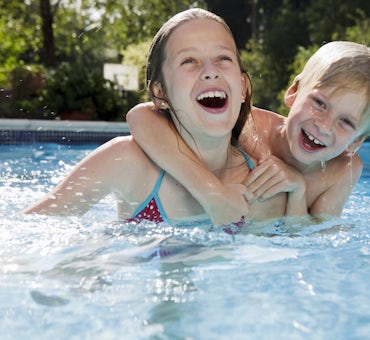Whether you own a deck, patio, terrace, or backyard, having an outdoor heater means you can enjoy your outside area year-round – even if it’s cold. In this article, we look into the outdoor heating options available to help you decide which one to choose.
What is the best outdoor heater for a deck or backyard – electric, gas, wood or biofuel?
Confused about what outdoor heating to choose? Electric heaters, gas heaters, wood-fired, or biofuel? Read this article, to find out more about the pros and cons of each option so that you can pick the right one for your needs.
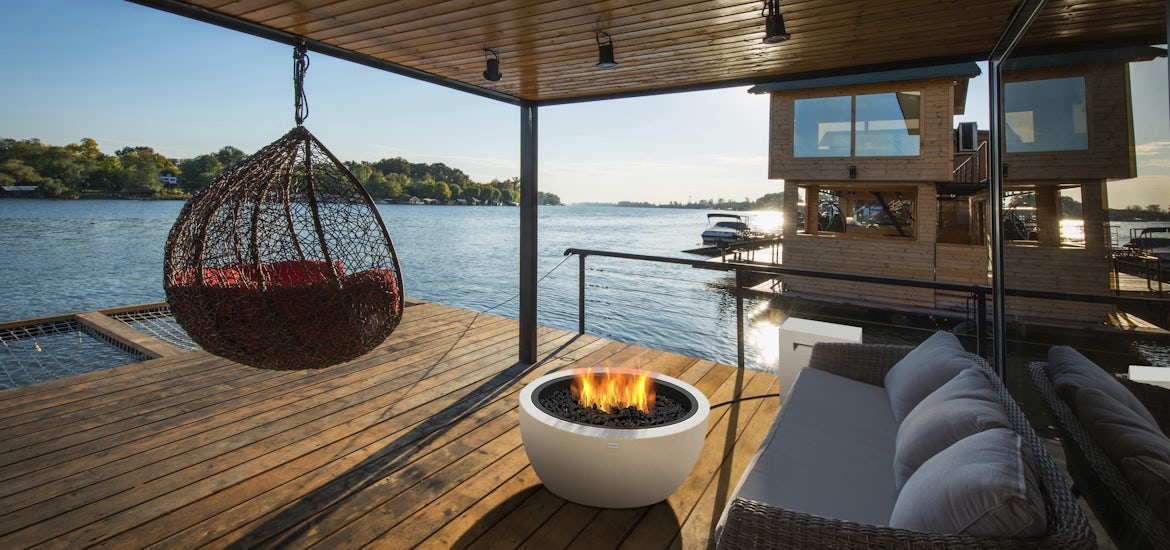
What is an outdoor heater?
An outdoor heater is a heating appliance used to heat open spaces such as patios, decks, terraces, and backyards. Different sources like electricity, gas, propane, solid fuel like wood, and even biofuel can be used to power these heaters. They are available in many styles and sizes, and can be wall-mounted, floor-mounted, or fixed on a tabletop.
What is an outdoor electric heater?
Outdoor electric heaters are powered by electricity from the grid. They work by directing a concentrated beam of heat and usually come in a strip design and can be mounted to the wall, floor, or ceiling. They are much more efficient than gas or wood heaters, but they can be more expensive to run. To find out how much it costs to run an outdoor electric here, read the article below.
Electric heaters are available in various sizes, so there is definitely something that is the right one for your space. Smaller areas might need just one heater, while bigger spaces may require several.
They’re also quite easy to use, cleaner to operate than other heaters, and won’t require a lot of maintenance. You can even install a timer controller to help cut down on energy usage.
Below are some of the types of electric heaters.
- Convector heaters. Convector heaters (also known as convection heaters) work by drawing cold air over a heating coil to produce hot air. As per the natural law of convection, the heated air becomes denser – making it rise while pushing cooler air down. Then, the cold air below gets drawn into the convector heater to produce more hot air, and this cycle creates the convection current. The warm air is replaced with cooler air from the vents, and the cycle continues until the desired temperature is reached.
Convection heaters are ideal for heating up whole rooms and even spacious areas such as living rooms. They can operate with almost no noise; however, there are some models that produce some noise such as those that are fitted with a fan to make the heating process faster.
- Electric fire heaters. Similar to how convector heaters work, electric fire heaters (or electric fireplaces) draw in cold air into a heating coil system to produce warm air, which is then dispersed through a fan.
Electric fire heaters create a comforting, calming glow and a cozy feeling by recreating the flickering flame effect of a real fire, minus the chimney. This type of heater is available in a number of styles, including wall-mounted, freestanding, and inset varieties.
- Radiant electric heaters. Radiant heaters (i.e. infrared heaters) work in the same way the sun does. Unlike traditional heaters, radiant heaters don't use visible light to warm up an area. Instead, they emit a type of energy that's invisible to the human eye. The heat energy provides a comfortable warmth that feels like the sun’s energy.
This type of electric heater heats up an area using radiation rather than heat conduction or convection and has the advantage of heating a space far more quickly and efficiently.
Pros of outdoor electric heaters
- They are relatively safe to use.
- They are easy and simple to operate; all you need to do is set up your heater where you want it, plug it in, and switch it on.
- Many electric heaters come with a thermostat and can turn on automatically when the temperature drops below a certain level.
- Electric heaters can direct heat at a specific area, rather than the space above.
- Electric heaters don't release carbon dioxide into the atmosphere, making them environmentally friendly.
- Electric heaters are completely odour and toxin-free.
- Available in a wide variety of sizes and shapes.
- Can be attached to outdoor furniture and accessories such as a pergola and an umbrella.
- Electric heaters are quiet. Unlike some gas heaters where you can hear the fuel being burned.
Cons of outdoor electric heaters
- They need electricity and can only be operated in locations with nearby electrical outlets or wiring.
- They produce less heat and warm up the surrounding area more slowly than heaters powered by wood, natural gas, or propane.
- Depending on the cost of electricity prices, they are a little more expensive to run than a wood or gas powered heater.
- They don't produce an ambient glow like a wood or gas fire
What is an outdoor gas heater?
Gas heaters are an excellent way to provide heat in your outdoor space. They're portable and can heat decks, patios, terraces, pools, and even bars and restaurants. They work more effectively when positioned in the centre of an outdoor space since they provide a steady stream of heat.
Gas heaters can be connected to your natural gas line, while portable gas heaters need a propane or LPG gas canister. If you have a small outdoor space, tabletop heaters are suitable. However, freestanding heaters are needed for larger ones. You may need more than one to offer adequate warmth for larger spaces or if you live in an area with harsh winters.
Compared with propane gas and LPG, natural gas heaters are generally more affordable to run because of the lower supply costs. However, users must pay an additional "supply charge" for having mains gas connected to their residence. This amount varies depending on the energy retailer and area. Natural gas is not available in all areas of Australia.
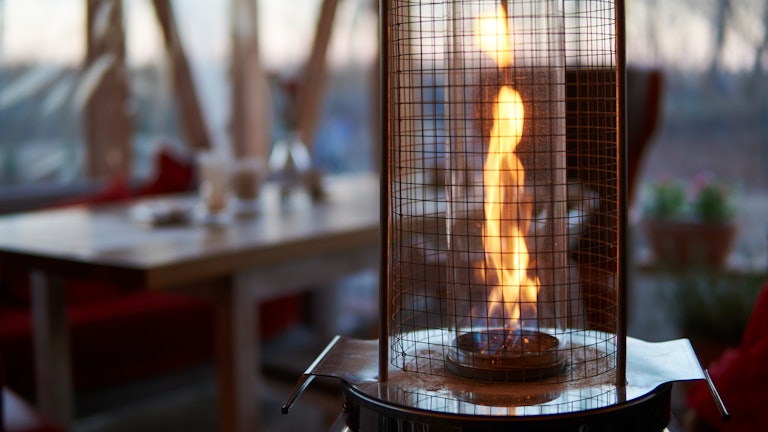
Pros of outdoor gas heaters
- Gas heaters have lower long-term costs than other systems, despite the fact that they may be more expensive initially.
- They are easier and simpler to maintain and burn cleaner than wood.
- Because gas burns more efficiently than other fuels, gas heaters provide more heat, making the space heat up faster. They are warmer than electric heaters.
- Gas heaters powered by propane are flexible and easy to set up. They are portable and can easily be moved from one area to another.
Cons of outdoor gas heaters
- Wall-mounted gas heaters must be professionally installed.
- Natural gas needs direct fuel sources and permanent gas lines which raises the initial cost. While gas heaters powered by propane need to have their propane tanks bought and replaced.
- As a non-renewable fuel, outdoor gas heaters are significantly less eco-friendly than electric heaters and renewable fuel sources like biofuel.
- Not as visually appealing as other heaters like fire bowls and fire tables.
What is an outdoor wood heater?
When it comes to heating huge places, wood heaters are the best. There are radiant wood heaters that will radiate heat naturally. While some modern wood heaters have fans that help push warm air out and circulate the space more quickly. Depending on your needs, wood heaters come in a variety of sizes and designs, including built-in and freestanding models.
There are several choices available, including the following:
-
Wood heater. A wood heater is described as a safe choice that holds heat well and can quickly warm up big areas. It is typically put into enclosed, undercover outdoor areas. There are numerous designs that provide varying radiant heat.
-
Firepit. With a variety of shapes and sizes, the firepit is designed for an open fire that you may build up with as much wood as the pit allows. Because of its design, it can be a great centrepiece that people can gather around.
-
Brazier. It features an upright metal bowl design, coated with high-temperature resistant powder, and tiny mesh to prevent sparks.
-
Chiminea. Because of its enclosed design, a chiminea is a great wood heater alternative that prevents ash or smoke from blowing in your face. It is available in several forms and shapes. If you're looking for a portable fireplace, this is useful because it keeps heat and the wind doesn't bother the flames.
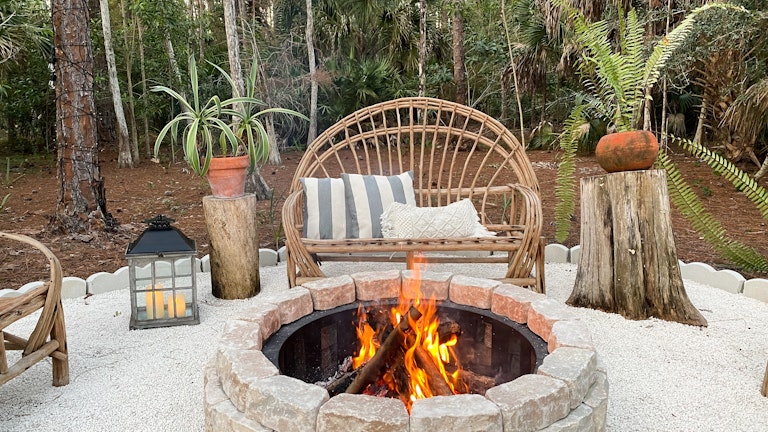
Pros of outdoor wood heaters
- They are the most affordable option.
- These types of heaters offer a campfire-like environment and produce a really nice ambience for those seated around.
Cons of outdoor wood heaters
- They require regular maintenance because soot, ash, and coals need to be removed frequently.
- They can be dangerous if left unattended due to the sparks and embers they emit.
- You need to stock enough wood to heat the entire space during colder months. Maintaining that stockpile of wood could be a hassle.
- They emit a lot of smoke, which may make people feel uncomfortable and leave a smokey smell on clothes. Smoke can also be harmful to your health if you are exposed to it for extended periods of time. Wood heaters might not be suitable for people with lung conditions such as asthma.
- Not suitable for use in built-up areas.
- Not as environmentally friendly.
What is an outdoor biofuel heater?
Biofuel heaters primarily use bioethanol as fuel. Instead of using gas or wood, bioethanol fuel can be a source of real-flame heat. Produced from plants such as corn, sugar cane, beets, and potatoes. Biofuel is natural, environmentally friendly, and a great alternative source of heat.
Because they don't require gas lines or electrical connections, bioethanol heaters are incredibly easy to use. You simply pour ethanol into the stainless steel burner to start the ethanol heater. The heater comes with the necessary lighting equipment to ignite the fuel. The bioethanol simply burns in the stainless steel burner, releasing heat, steam, and carbon dioxide. After that, the fuel will burn for up to 4-5 hours, depending on the size of the burner.
You should only replenish your burner once it has cooled back to room temperature in order to guarantee the safety of your heater at all times. Depending on how long it has been in use, the model, and other factors in the room, this might take up to an hour. You can extinguish the flame by simply closing the lid to deprive it of oxygen.
Watch: Martini 50™ Fire Table (Biofuel)

Pros of outdoor biofuel heaters
- These are renewable sources of energy and are eco-friendly.
- They are cost-effective because there is no need for additional power or fuel sources from gas or electricity.
- They burn cleanly, don't emit any unpleasant pollutants and toxins, and don't leave behind dust and ashes that need to be cleaned up afterwards.
- They need little maintenance and are simple to set up and refuel.
- They are available in a broad range of options in terms of design and forms, such as freestanding, wall-mounted, firebox, and grate kits.
Cons of outdoor biofuel heaters
- They are not intended to be a primary source of heat, just a supplement.
- Care is required when handling fuel.
- Biofuel is not suitable for cooking food on
- Compared to an outdoor wood heater or electric heater, it doesn't produce as much heat.
In Summary
Outdoor heating is a good way to extend your living area outdoors, all year long.
In this article, we have discussed the different outdoor heating options: electric heater, gas heater, wood, and biofuel. Before you choose, it's important to think about various factors and considerations, such as your deck or backyard space, heat requirements, and maintenance. You should carefully evaluate all the potential benefits and drawbacks of each type before making the final decision.
Do some extra research and if you're unsure of the best options for your home, then talk to experts and ask for guidance. After all, you need to buy the one that will work best for your needs.
Related Articles
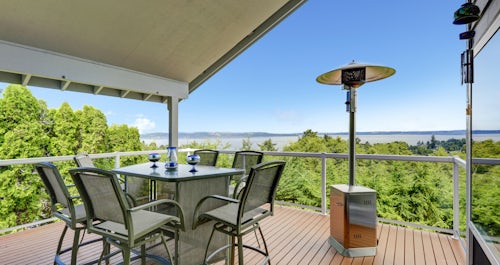
What outdoor heating should I choose in 2025?
When it comes to outdoor heating, there are a whole range of options out there – from outdoor fireplaces to electric or gas heaters, and everything in between. In this article learn about the best top 5 outdoor heater options to compare and consider for your space.
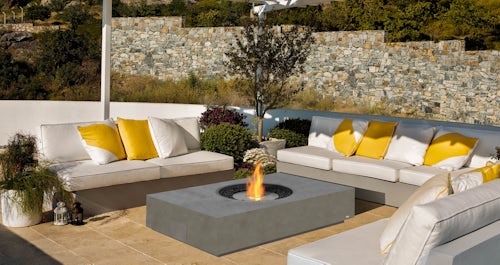
What is a fire table and should I buy one?
Looking for a stylish, versatile and energy efficient outdoor heater in Australia? How about a fire table? In this article and video you will learn about the features and benefits of a fire table and why it could be an ideal heater for you.
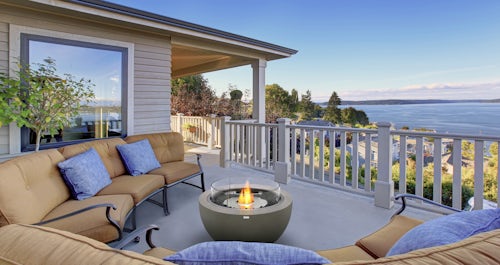
Best outdoor heating Australia 2025 (Pros, cons, comparisons and more)
Are you thinking of buying or installing outdoor heating? Wondering what to buy? This article compares pros and cons of fire tables, fire pits, patio heaters and more.

Outdoor fire and heater running costs in 2025 (Pros, cons and more)
Thinking about installing an outdoor heater or fire? Concerned about the running costs? This article compares the top options, costs, pros, cons and more.
